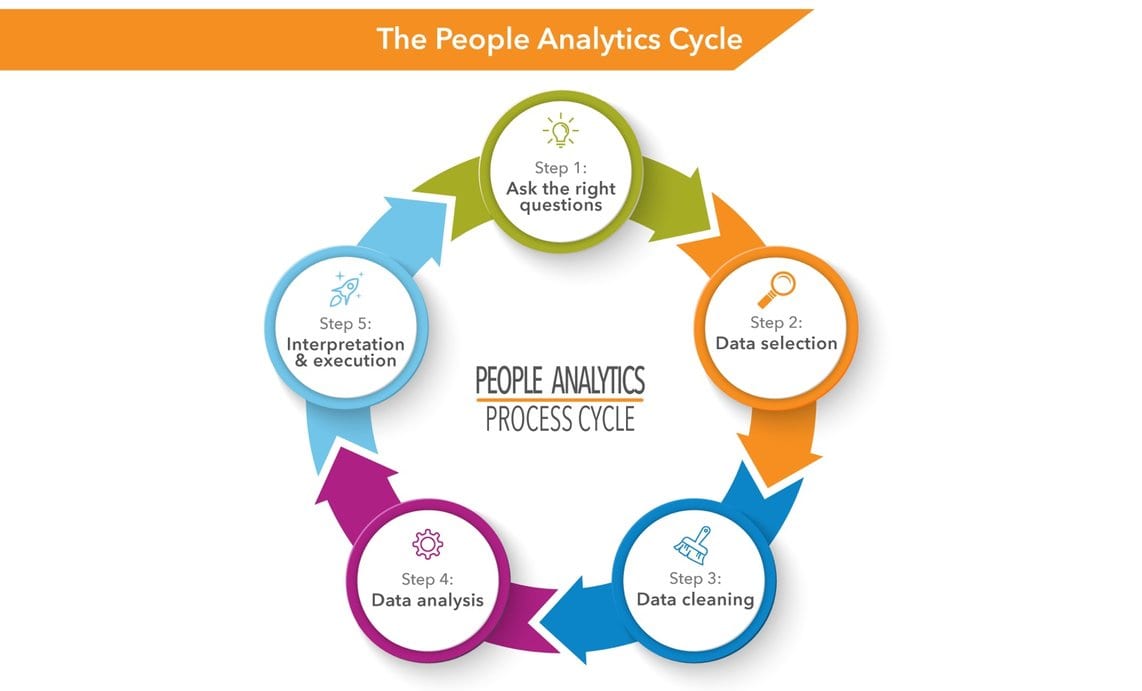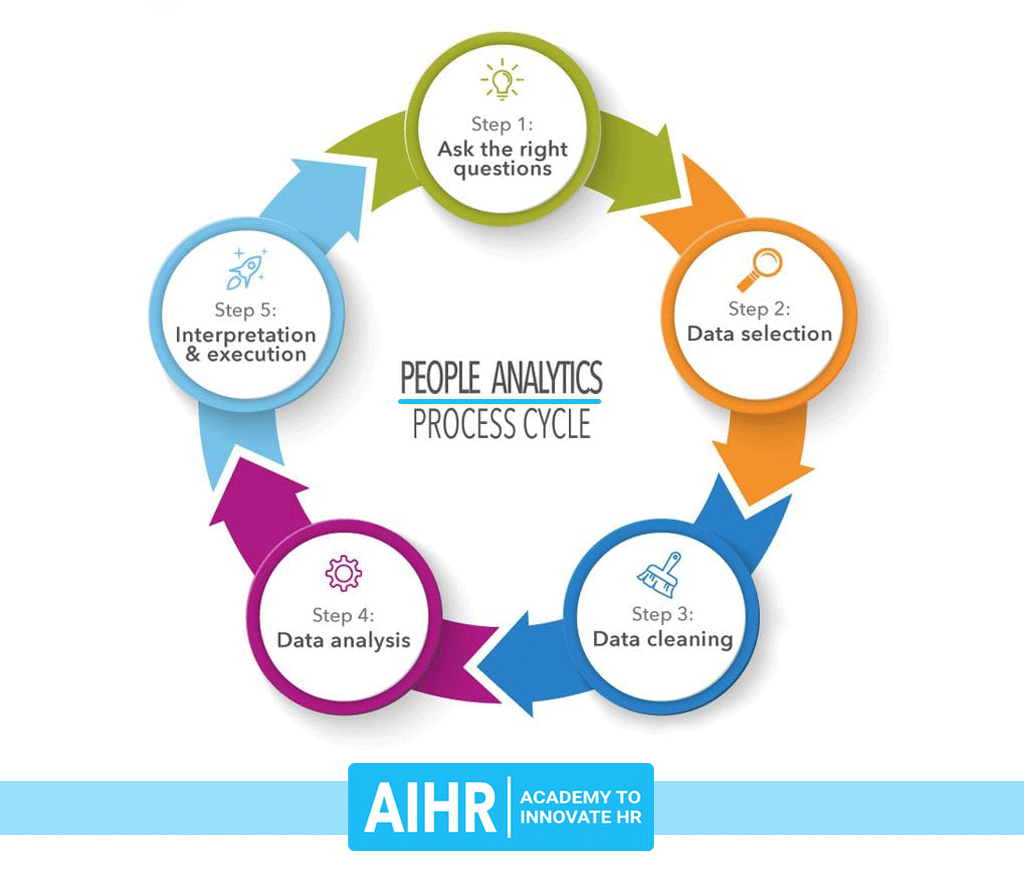The People Analytics Cycle

HR analytics is exciting and offers great opportunities. Unfortunately, not all projects are successful, and a common reason for this is a lack of a structured approach towards analytics. The people analytics process cycle solves this.
The people analytics process can be divided in five sequential steps. Every organization should take these steps in order to successfully apply analytics. Depending on your organization’s people analytics maturity level your HR analytics team might have already taken some of these steps.
In each of the following chapters we will describe a different step.
- Chapter 6 – Asking the right questions
- Chapter 7 – Selecting the right data
- Chapter 8 – Cleaning the data
- Chapter 9 – The basics of data analysis
- Chapter 10 – Interpretation and execution
The people analytics cycle involves five steps, which are often repeated multiple times to successfully use analytics to solve a business problem.
Before you start to analyze data, you will need to know what questions you want to answer, or what hypothesis you want to validate. Don’t just start with any question: Choose a question that is the CEO’s top priority.
Chapter 6. Asking the right question
The first step in the people analytics process is about asking the right question. All research starts with one or more questions or hypotheses. They provide guidance as they structure the entire research project. Your hypothesis influences what data you need to select, how you analyze your data and what actions you take to execute on the insights that the data yields. Thus, this chapter will examine how to ask the right question.
When you start with people analytics, it is important to know the broader business context. Because the people analytics team ideally solves problems that the business struggles with, this connection is crucial. Consider the following example:
“The HR director of a large company in the Netherlands was very keen on developing people analytics capabilities. To do so, he created an analytics task force and hired a data scientist. The task force was made up of four highly motivated people who started to dig around in the data. Based on the available data and literature, the team decided to attempt to predict employee churn.
After selecting the relevant variables, the team started to structure and clean the data. After a few months, the team was able to predict which employees were likely to leave the organization within the next year.
This was an amazing discovery and a win for the people analytics team. The team was also able to identify factors that contributed towards employee turnover and could advise manager and HR business partners based on their data. In the end, they created a dashboard that was accessible to key managers inside the organization.
However, this dashboard was very rarely used. Hardly any manager logged into the system and even fewer acted on the information. This puzzled the analytics team. When asked about it, a senior manager said: “I just don’t see it as a problem. It is okay when people leave because it gives others in the organization a chance to be promoted to those positions”.
The company’s average turnover was around 6% (including retirement), which is the Dutch average turnover. This means that the average employee stays with the company for an average of almost seventeen years. The Netherlands has a very loyal workforce. Indeed, the Netherlands has the lowest employee turnover in Europe. The data produced by HR was interesting, but not at all relevant to the company.
Managers did not perceive employee turnover as problematic. Conversely, these managers were often trying to promote and reward their high potentials. When a position would open up this was always welcomed because it would enable them to internally promote their high potentials. The people analytics solution was not in line with the business’ primary concern and therefore did not add any value.”
Always start with a business priority
People analytics provides both HR and the CEO with tools to produce amazing insights. Once a good analytics team is in place, its success within the organization depends on whether or not it is able to solve important business problems.
If it is unable to do so, it can potentially produce very interesting results which do not benefit the business at all, like you saw in the example above. In order to have a strategic role, the team needs to focus on a real business problem. The team should therefore define the top business priorities within the organization. When these priorities can be solved using people analytics, the team adds real value to the organization.
This point is emphasized in a recent publication on Human Resources analytics by Rasmussen and Ulrich (2015) . According to them, HR analytics begins too often by studying the data without looking at the real challenges that the business faces. This approach greatly diminishes the value of HR analytics. Indeed, Rasmussen and Ulrich warn that this approach could subdue the impact of HR analytics and reduce it to a short-lived craze.
The CEO is not concerned with employee birthdays, nor is he interested in the number of signups for employee benefits programs, optimizing HR’s performance, call center volumes or HR delivery costs. The CEO is concerned about whether he has the right people. He is concerned about whether his company will reach its diversity goals and thus avoids bad PR, he is concerned about the cost of turnover, and about reducing these costs when they start to negatively influence the company’s bottom line performance.
Of course, these topics differ per country, organization and industry…
Sources:
Rasmussen, T., & Ulrich, D. (2015). Learning from practice: how HR analytics avoids being a management fad. Organizational Dynamics, 44(3), 236-242.
Weekly update
Stay up-to-date with the latest news, trends, and resources in HR
Learn more
Related articles
Are you ready for the future of HR?
Learn modern and relevant HR skills, online













